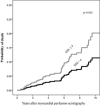Prognostic value of myocardial perfusion abnormalities for long-term prognosis in patients after coronary artery bypass grafting
- PMID: 25400360
- PMCID: PMC4228584
- DOI: 10.4103/0972-3919.142623
Prognostic value of myocardial perfusion abnormalities for long-term prognosis in patients after coronary artery bypass grafting
Abstract
Aims: The objective was to evaluate the prognostic value of exercise myocardial perfusion scintigraphy (MPS) in patients who underwent coronary artery bypass grafting (CABG).
Subjects and methods: A retrospective, one-center study of 361 patients with multivessel coronary artery disease was carried out. All the patients underwent MPS after CABG due to worsened health status. MPS was performed at 4.5 years standard deviation (SD: 0.2), based on symptoms. MPS was carried out using Tc-99m methoxy isobutyl isonitrile and following a 1-day protocol (stress-rest). The end points were analyzed at 6.5 years (SD: 3.3) after MPS, on the average.
Statistical analysis used: SPSS software for Windows, version 13.0. The t-test or the χ(2)-test was used. Survival times were calculated. A multivariate Cox proportional hazards model was developed.
Results: During the follow-up, death occurred in 54 patients, and 37 patients experienced major adverse cardiovascular events (MACE). In the multivariate analysis, advanced age hazard ratio (HR: 1.45; 95% confidence interval [CI]: 1.4-2.02; P = 0.027), previous myocardial infarction (HR: 3.17; 95% CI: 1.22-8.2; P = 0.018), left ventricular ejection fraction of <40% (HR: 2.16; 95% CI: 1.2-3.89; P = 0.01), and the summed stress score (SSS) of ≥4 (HR: 1.87; 95% CI: 1.02-3.41; P = 0.04) were independent predictors of all-cause death. The summed difference score (SDS) was the only independent predictor of MACE (HR: 1.26; 95% CI: 1.06-1.48; P = 0.034).
Conclusions: The parameters of MPS were found to have prognostic value in the long-term period after CABG. Advanced age, previous myocardial infarction, decreased left ventricular ejection fraction, and the abnormal SSS were associated with an increased risk of all-cause death. The SDS was found to be the only significant risk factor for MACE.
Keywords: Long-term prognosis; myocardial perfusion scintigraphy; myocardial revascularization.
Conflict of interest statement
Figures
Similar articles
-
[Predictive value of left ventricular ejection fraction reserve assessed by SPECT G-MPI for major adverse cardiovascular event in patients with coronary artery disease].Zhonghua Xin Xue Guan Bing Za Zhi. 2023 Jun 24;51(6):626-632. doi: 10.3760/cma.j.cn112148-20220919-00730. Zhonghua Xin Xue Guan Bing Za Zhi. 2023. PMID: 37312481 Chinese.
-
Predictive and prognostic value of left ventricular mechanical dyssynchrony assessed by myocardial perfusion single photon emission computed tomography in asymptomatic patients under hemodialysis.Nucl Med Commun. 2018 May;39(5):423-429. doi: 10.1097/MNM.0000000000000816. Nucl Med Commun. 2018. PMID: 29629998
-
Long-term Outcomes in Patients With Severely Reduced Left Ventricular Ejection Fraction Undergoing Percutaneous Coronary Intervention vs Coronary Artery Bypass Grafting.JAMA Cardiol. 2020 Jun 1;5(6):631-641. doi: 10.1001/jamacardio.2020.0239. JAMA Cardiol. 2020. PMID: 32267465 Free PMC article.
-
Percutaneous Coronary Intervention vs Coronary Artery Bypass Grafting in Patients With Left Main Coronary Artery Stenosis: A Systematic Review and Meta-analysis.JAMA Cardiol. 2017 Oct 1;2(10):1079-1088. doi: 10.1001/jamacardio.2017.2895. JAMA Cardiol. 2017. PMID: 28903139 Free PMC article.
-
Stroke Rates Following Surgical Versus Percutaneous Coronary Revascularization.J Am Coll Cardiol. 2018 Jul 24;72(4):386-398. doi: 10.1016/j.jacc.2018.04.071. J Am Coll Cardiol. 2018. PMID: 30025574
Cited by
-
Comparison of the Diagnostic Performance of Myocardial Perfusion Scintigraphy with and Without Attenuation Correction.Mol Imaging Radionucl Ther. 2022 Jun 27;31(2):130-138. doi: 10.4274/mirt.galenos.2021.27880. Mol Imaging Radionucl Ther. 2022. PMID: 35771002 Free PMC article.
References
-
- Task Force on Myocardial Revascularization of the European Society of Cardiology (ESC) and the European Association for Cardio-Thoracic Surgery (EACTS), European Association for Percutaneous Cardiovascular Interventions (EAPCI), Wijns W, Kolh P, Danchin N, Di Mario C, et al. Guidelines on myocardial revascularization. Eur Heart J. 2010;31:2501–55. - PubMed
-
- Zellweger MJ, Lewin HC, Lai S, Dubois EA, Friedman JD, Germano G, et al. When to stress patients after coronary artery bypass surgery? Risk stratification in patients early and late post-CABG using stress myocardial perfusion SPECT: Implications of appropriate clinical strategies. J Am Coll Cardiol. 2001;37:144–52. - PubMed
-
- Acampa W, Petretta MP, Daniele S, Perrone-Filardi P, Petretta M, Cuocolo A. Myocardial perfusion imaging after coronary revascularization: A clinical appraisal. Eur J Nucl Med Mol Imaging. 2013;40:1275–82. - PubMed
-
- Hendel RC, Berman DS, Di Carli MF, Heidenreich PA, Henkin RE, Pellikka PA, et al. ACCF/ASNC/ACR/AHA/ASE/SCCT/SCMR/SNM 2009 Appropriate Use Criteria for Cardiac Radionuclide Imaging: A Report of the American College of Cardiology Foundation Appropriate Use Criteria Task Force, the American Society of Nuclear Cardiology, the American College of Radiology, the American Heart Association, the American Society of Echocardiography, the Society of Cardiovascular Computed Tomography, the Society for Cardiovascular Magnetic Resonance, and the Society of Nuclear Medicine. J Am Coll Cardiol. 2009;53:2201–29. - PubMed
-
- Shaw LJ, Iskandrian AE. Prognostic value of gated myocardial perfusion SPECT. J Nucl Cardiol. 2004;11:171–85. - PubMed
LinkOut - more resources
Full Text Sources
Other Literature Sources


